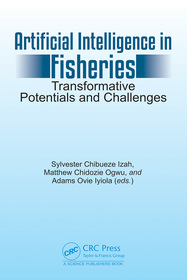
Artificial Intelligence in Fisheries
Transformative Potentials and Challenges
-
10% KEDVEZMÉNY?
- A kedvezmény csak az 'Értesítés a kedvenc témákról' hírlevelünk címzettjeinek rendeléseire érvényes.
- Kiadói listaár GBP 130.00
-
62 107 Ft (59 150 Ft + 5% áfa)
Az ár azért becsült, mert a rendelés pillanatában nem lehet pontosan tudni, hogy a beérkezéskor milyen lesz a forint árfolyama az adott termék eredeti devizájához képest. Ha a forint romlana, kissé többet, ha javulna, kissé kevesebbet kell majd fizetnie.
- Kedvezmény(ek) 10% (cc. 6 211 Ft off)
- Kedvezményes ár 55 897 Ft (53 235 Ft + 5% áfa)
Iratkozzon fel most és részesüljön kedvezőbb árainkból!
Feliratkozom
62 107 Ft

Beszerezhetőség
Becsült beszerzési idő: A Prosperónál jelenleg nincsen raktáron, de a kiadónál igen. Beszerzés kb. 3-5 hét..
A Prosperónál jelenleg nincsen raktáron.
Why don't you give exact delivery time?
A beszerzés időigényét az eddigi tapasztalatokra alapozva adjuk meg. Azért becsült, mert a terméket külföldről hozzuk be, így a kiadó kiszolgálásának pillanatnyi gyorsaságától is függ. A megadottnál gyorsabb és lassabb szállítás is elképzelhető, de mindent megteszünk, hogy Ön a lehető leghamarabb jusson hozzá a termékhez.
A termék adatai:
- Kiadás sorszáma 1
- Kiadó CRC Press
- Megjelenés dátuma 2025. augusztus 25.
- ISBN 9781032816883
- Kötéstípus Keménykötés
- Terjedelem320 oldal
- Méret 234x156 mm
- Súly 750 g
- Nyelv angol
- Illusztrációk 14 Illustrations, black & white; 5 Illustrations, color; 5 Halftones, color; 14 Line drawings, black & white 690
Kategóriák
Rövid leírás:
Artificial intelligence (AI) is transforming fisheries research by enhancing fish population estimates, predicting stock dynamics, and improving sustainability. AI analyzes ocean data to forecast climate patterns, supports species identification, and enforces regulations, reducing bycatch and waste.
TöbbHosszú leírás:
Artificial Intelligence in Fisheries delves into the transformative role of AI in the fisheries and aquaculture. It provides a comprehensive overview of how AI applications—from fish stock assessment and environmental monitoring to sustainable aquaculture and policy development—are revolutionizing the sector. By enhancing data-driven decision-making, increasing efficiency, and addressing ecological challenges, this book serves as a practical guide for scientists, industry professionals, and policymakers.
With contributions from experts, scholars and practitioners, the book brings together theoretical foundations and real-world applications to explore AI's potential to drive sustainable practices in fisheries. Readers will gain insight into how AI can help optimize resource use, protect endangered species, and promote responsible fishing practices. It offers valuable perspectives and actionable strategies to support the future of sustainable fisheries and aquaculture.
TöbbTartalomjegyzék:
Preface. Artificial Intelligence in Fisheries: Transformative Potentials and Challenges. Data analysis and machine learning in Aquaculture: An innovative approach. Collaborate Approaches to Sustainable Fisheries with Artificial Intelligence. Fish Stock Assessment Using AI Algorithms. Sustainability Through AI in Fisheries. Artificial Intelligence for Monitoring Aquatic Pollutants: Safeguarding Ecosystem Health and Sustainable Fisheries Development. AI-Enhanced Environmental Impact Assessments in Recreational Fisheries. Artificial Intelligence Enhanced Aquaculture Practices. Computer Vision for Fish Species Identification. Deciphering Artificial Intelligence’s Impact on Fisheries Policy and Regulation for Sustainable Fisheries. Unraveling the Role of Artificial Intelligence in the Analysis of Oceanographic Data. Job Opportunities in the AI and Tech Sector. Promoting Responsible Fishing Practices with AI. AI’s Contribution to Endangered Species Conservation. Index.
Több



